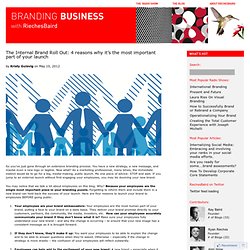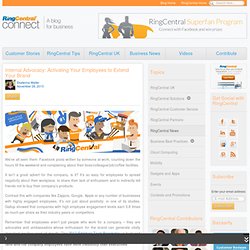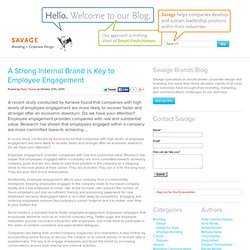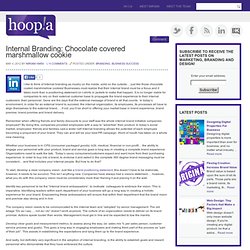

Strategic. School brand audit (SBA) » Brand Audits - A diagrammatic depiction. Having engaged in a brand audit exercise for Fujitsu in India many years ago, I recall the exercise that Coopers and Lybrand had run for us.

It was a tremendous learning experience and my first exposure to the complex and exciting world of branding. While searching for online branding models on Google, I came across this mindmap which was created by Martin Jelsema a branding specialist. I’m enclosing the same with this entry. A brief note on this : the brand audit that I worked on involved multiple interviews with customers, brand managers, marketing team members and other stakeholders. It was a long drawn exercise which involved questions on all aspects of the brand. The Internal Brand Roll Out: 4 reasons why it's the most imporant part of your launch.
So you’ve just gone through an extensive branding process.

You have a new strategy, a new message, and maybe even a new logo or tagline. Now what? As a marketing professional, many times, the immediate instinct would be to go for a big, media-making, public launch. My one piece of advice: STOP and wait. If you jump to an external launch without first engaging your employees, you may be dooming your new brand. You may notice that we talk a lot about employees on this blog. What Does Your Employer Branding Fishbowl Look Like?
Every company has two distinct brands, its employer brand and its consumer brand.

With the rise of social networking, your company, how you run it and your culture has become a fishbowl — everything you do is on display for all to see. And like it or not, your employees have an abundance of channels for broadcasting their opinions — both negative and positive. Company branding and employer branding aren’t the same, but they intersect to fuel each other. Many of the same characteristics that motivate consumers also motivate job seekers. Successful companies foster a culture where employees not only like where they work but also believe in the products and solutions they support. The employer brand is comprised of a myriad of factors that contribute to how your employees learn, plan and do their work and personal lives. 1.
Today real-time career development can be facilitated with some imagination, technology devices, innovation and focus. 2. 3. Internal Advocacy: Activating Your Employees to Extend Your Brand. We’ve all seen them: Facebook posts written by someone at work, counting down the hours till the weekend and complaining about their boss/colleague/job/coffee facilities.

It isn’t a great advert for the company, is it? It’s so easy for employees to spread negativity about their workplace, to share their lack of enthusiasm and to indirectly tell friends not to buy their company’s products. Contrast this with companies like Zappos, Google, Apple or any number of businesses with highly engaged employees. It’s not just about positivity: in one of its studies, Gallup showed that companies with high employee engagement levels earn 3.9 times as much per share as their industry peers or competitors. Remember that employees aren’t just people who work for a company – they are advocates and ambassadors whose enthusiasm for the brand can generate vitally important positive word of mouth.
A Strong Internal Brand is Key to Employee Engagement. A recent study conducted by Kenexa found that companies with high levels of employee engagement are more likely to recover faster and stronger after an economic downturn.

Do we have your attention? Employee engagement provides companies with real and substantial value. Research has shown that employees engaged within a company are more committed towards achieving … A recent study conducted by Kenexa found that companies with high levels of employee engagement are more likely to recover faster and stronger after an economic downturn. Do we have your attention? Employee engagement provides companies with real and substantial value. Additionally, employee engagement affects your company from a sustainability standpoint. Internal Branding: Chocolate covered marshmallow cookie. I like to think of Internal branding as mushy on the inside, solid on the outside… just like those chocolate coated marshmellow cookies!

Businesses must realize that their internal brand must be a focus and it takes more than a positioning statement on t-shirts or jackets to make that happen. It is no longer viable for companies to rely on their external customer base to propagate the brand experience to their internal customers: their personnel. Gone are the days that the external message of brand is all that counts. City of Paris » Effective Internal Communications and Brand Management. By Donna Vetter The most challenging aspect of internal communications seems to be one of the easiest: engaging brand stakeholders with need-to-know information, when they need to know it.

The reality is, it’s not as easy as it sounds. No brand escapes the consequences of poor internal communications. Internal marketing roadways. Internal Brand Communication. 6 Tips for Internal Brand Communication: An internal brand is a set of qualities and values that influences how a company’s external brand is lived up to within the organization.

Internal brand values may include such elements as integrity, service, teamwork, flexibility, an energizing environment, continued learning, collaboration, work-life balance, flexibility, and so on. When employees embrace the internal brand, employee turnover is likely to be reduced, attendance is increased, and customers become happier. Talent Management Lessons From Apple… A Case Study of the World’s Most Valuable Firm (Part 3 of 4) "Why join the Navy, if you can be a pirate? " Want to impress your CEO? Few CEOs wouldn’t mind having the innovation track record of Apple, so there is probably no quicker way to become an “instant hero” then by learning how Apple’s talent management practices have contributed to its success and applying those practices relevant to your organization.
In this installment of the case study, we’ll look at internal branding, employer branding, and recruiting. HOW TO: Help Employees Talk About Your Brand Online. This series is supported by IGLOO, a leader in helping organizations improve business processes, increase employee productivity and enhance stakeholder engagement inside and outside the organization using social technologies.

For many brand managers, employees' actions online remain a daunting, untamed frontier. The brand's consistent, controlled message to consumers melds with internal messaging and individuals' stories when employees take to the social web. The cautionary tales of the social web's early days — stories of indiscretion, mixed signals and poor communication — have led to an increase in strict policies and careful monitoring of employee social media activities in many cases.
But lately, a few savvy brands have changed their internal position about employees' activities on the social web. At many organizations, we've moved beyond firings over Facebook faux pas and are actively looking for even more ways for employees to use social media both personally and professionally.